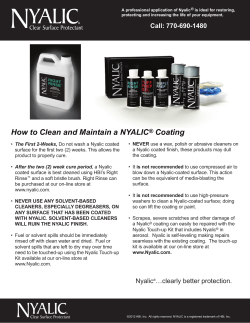
Investigationof MechanicalProperties of Al2O3/PU Coated PES Fabric
Investigationof MechanicalProperties of Al2O3/PU Coated PES Fabric A.Koruyucu1, A.Ö.Ağırgan1, M.Ağırgan2 1 Departments of TextileEngineering, Namık Kemal University, Corlu,Tekirdag,Turkey adelituna@nku.edu.traoagirgan@nku.edu.tr Abstract: In this study, the influences of two different concentration of Al2O3 particles in PU coating solution and the amounts of coating thickness on mechanical properties of polyurethane coated polyester fabrics were investigated. Keywords: mechanical properties; fabrics; polyurethane; coatings. 1. Introduction Textilesurfacematerialscoatedwithchemicalstructureshavebeendevelopedcontinuouslyforsever allastdecades. The basic substrate of the surface material is mostly textilefabriccoated on oneorbothsideswithoneormorepolymerlayers. Thiskind of productswiththebasictextilematerial has manyimprovedpropertiesandmultipleadvantagesovertheclassictextilematerial [1-3]. Polymerlayer can be polyurethane. Toimproveitsproperties, appropriateadditivesareadded: fillingmaterials, bindersetc. Coatedpolymersareappliedtothetextilematerialdirectlyandindirectly. The chemicalcompositions of polymercoatingsareconstantlydevelopedandnewtypes of polymeradditivesareincreasinglyintroduced. Abrasionresistanceandstrengthareby far higher inpolyurethane in comparisontootherpolymers. Polyurethane has theproperty of goodadhesionwhich can be strengthenedbyaddition of cross-linkingagents [1,4]. 2.Materials and Methods 2.1.Coating of fabrics Scoured polyester microfibrefabrics of weight 93,8 g m-2wascoatedbyknifeover roller machine. The coatedfabricsweredried at 120 ° C for 2 minandthencured at 150 ° C for 2 min. The thickness of thecoatedfabricswere 0,05 and 0,1 mm, respectively. 2.3. Material Mechanical Performance Tests ISO test methods 13934-2, ISO 13937-1and 12947-4 wereemployedforbreakingstrength, tearingstrengthandmartindaleabrasionfabrictesting. Allfabricsweretested in thewarpdirectionand in theweftdirectionwhensamplequantityandgeometryallowed. Formechanicaltestingthreereplicationswereconducted on eachsample. 3.Results 3.1.Breaking Test Results The breaking test results, summarized in Table 2, show a significant decrease in breaking force in warp directions and increase in weft directions compared to those of uncoated fabrics. Example breaking test plots from warp direction testing (meaning fill yarns broke) are reproduced in Figure 1. Visually, we noticed that uncoated samples caused more overall deformation than coated samples during the breaking load test. In warp direction, the application of coating decreased the breaking load substantially. While, increased coating thickness caused only a slight decrease in the breaking load, increased Al2O3 content caused a slight increase in the breaking load, as shown in Figure 1. Table 2. Breaking force test results Warp direction load (N) Weft direction load (N) Uncoated 558 676,5 0,05-10g Al2O3 482,76 733,8 0,05-20g Al2O3 490,2 784,35 0,1-10g Al2O3 456,83 598,6 0,1-20g Al2O3 458,7 604,15 Breaking Force (N) Sample 800 700 600 500 400 300 200 100 0 Warp Weft 0g 10 g 20 g 0g 10 g 20 g 0,05 0,1 PU coating thickness-Al2O3 content-warp and weft direction Figure 1. Breaking load test results 3.2.Tearing Test Results In this study, we use PN-EN ISO 13937-1:2000 standard “Textiles”. Tear properties of fabrics-Part 1. Determination of tear force using ballistic pendulum method” (Elmendorf). The method of sample preparation and its clamping in the jaws is shown in Figure 2. For clothing fabrics, the sample cut distance is 20 ± 0,5 mm and the tear distance is 43 ±0,5 mm. Figure 2.A method of sample preparation and of clamping in the Elmatear according to PN-EN ISO 13937-1:2002. The tear test results summarized in Table 3. They show a significant increase in tear strength in warp directions and decrease in weft directions compared to those of uncoated fabrics. In warp tearing load, the coated sample sustained less contraction. Table 3. The tear test results Sample Warp direction load (N) Weft direction load (N) Uncoated 14,83 15,94 0,05-10g Al2O3 16,46 13,01 0,05-20g Al2O3 15,24 12,86 0,1-10g Al2O3 17,58 15,33 0,1-20g Al2O3 15,69 13,99 Tearing Load (N) 18 16 14 12 10 8 6 4 2 0 Warp Weft 0g 10 g 20 g 0g 10 g 20 g 0,05 0,1 Tearing Load for Samples -Coating Thickness-Al2O3 content Figure 3.Contrast of warpandwefttearingloadforsamples As seen in theFigure 3, tearingforce of coatedfabric is highercomparedtouncoatedfabric. It is explainedthatcoatedfabricsbypolyurethane-Al 2 O3becomelesselasticforeasyformabilityandlowextensionandbreakingproperty. 3.3.Abrasion Test Results To test the abrasion resistance of polyurethane-Al 2 O3 coated fabrics, the determination of pilling in appearance by the EMPA standard SN 198525 after 30,000 cycles according to the ISO 12947-4 were used. Theabrasion test results summarized in Table 4. Table4. The abrasion test results Sample Pilling test values Uncoated 3-4 0,05-10g Al2O3 4-5 0,05-20g Al2O3 4-5 0,1-10g Al2O3 4-5 0,1-20g Al2O3 4-5 Inadditiontotheconsiderableincrease in abrasionresistance, thecoatusedcontributedto a verysignificantincreasein fabricresistancetopilling. Thetestsperformedshowthatthisresistanceof thefabricscoatedwasincreasedfromthelevel 2 – 3 foruntreatedfabrictothehighestlevel of assessment: 5, whichindicatesa smoothfabricsurfacewithoutanysigns of abrasivewear.Thisverygoodresistancetopilling isalsoillustrated in thephotos of fabricsamplestakenfromtheMartindaleapparatusafterthepilling test (30000cycles)-Figures 4a, 4b, 4c &4d showfabricscoatedwith PU-Al 2O3 . 4.Conclusions 1. It can be concluded from experimental results that breaking force and tearing force of coated fabrics exhibit different conclusions. Coated woven fabrics by polyurethane-Al 2O3 become more elastic. Therefore, breaking force of coated fabrics decrease compared to uncoated fabrics. However, tearing force of coated fabrics is higher than that of uncoated fabric. 2. The mechanical properties of the PU- Al2 O3coating can have a significant effect on the tear properties of coated woven fabrics. The tear properties of a PU-coated woven fabric depend on the coating thickness used. 3. The application of Al2O3 /PU-coatingappearstoimprovetheabrasionresistance of thesamples. An increase in thethickness of thecoatingalso has apositiveeffect on theabrasionresistance of thecoatedfabrics. References [1] I. Soljačić: “TextileCoating,” Tekstil 42 (12) 673-686 (1993.) [2] Y.E.ElMogahzy: “EngineeringTextiles, Integratingthe Design andManufacture of TextileProducts”, The TextileInstitute, Woodhead Publishing Limited, Cambridge England, 2009. [3] W. Fungand M. Hardcastle: “Textiles Automotive engineering”, The TextileInstitute, Woodhead Publishing Limited, Cambridge England, 2001. [4] M. Skoko: “Investigations of PropertiesandMultiaxialStrengthandDeformations of CoatedTextileFabrics”, Tekstil, 47 (7) 339-344 (1998.)
© Copyright 2025













